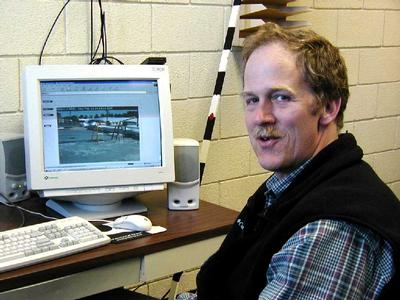12 April, 2001
John Gagnon, Civil Engineering Technician, Web Camera Images
Monitoring remote sites by installing web cameras for scientific
investigation is just one of John Gagnon's specialties at the Cold Regions
Engineering and Research Laboratory in Hanover, New Hampshire. John not
only has the opportunity to travel to unusual and interesting locations for
the installation of the CRREL web cameras but also develops the programming
for data acquisition and weather and climate processing and retrieval.
Because it's neither cost efficient nor time efficient to live on a river
bank, for instance, all winter taking regular photos of the climate changes
impacting the regions in question, John Gagnon's web cameras are quickly
becoming a significant mode of scientific documentation for CRREL's
projects. Subtle changes in the conditions that affect these monitored
studies are brought to life by assembling the images as animation.
Scientists can view their projects at remote sites from the convenience of
their office computer while conducting their other duties at CRREL.
It's not only cheaper to pay John Gagnon to install web cameras and monitor
the acquisition of their data, but efficient use of the scientists' skills
and time. John firmly believes in letting the computers do the work and he
has the expertise to make this happen.
Some past examples of the diverse studies that CRREL's web cameras have
focused on are:
* Missouri River in eastern Montana, documenting ice effects (movement and
bank erosion of sediment) and loss of valuable farmlands.
* University of Maine's bridge decking cooperative observing a variety of
composite materials for stronger and lighter materials for promoting bridge
durability.
* Yankton, South Dakota viewing endangered species of birds.
* Lake Bomosseen, Vermont, monitoring ice motion and identifying climate
changes triggering shore damage.
Active web cameras at CRREL's webcams site are:
* Hardwick, Vermont's low-cost ice control studying the prevention of ice
jams on small rivers (sloped-block ice control structure).
* Sault Ste. Marie, Michigan, Soo Lock's web camera on the St. Mary's River
monitoring vessel traffic.
* Missouri River at Bismarck, North Dakota, studying the control of river
water.
* Upstream of Rosseau Creek downstream of Oahe Dam monitoring ice control.
* Mission Point on the St. Mary's River observing the effects of booms for
ice control.
* Rock Island, Illinois monitoring ice condition for correlating with
sediment movement.
* St Regis River, Hogansburg, New York monitoring the river's impact of ice
on bridge structure.
* Sault Ste. Marie, Michigan, on St. Mary's River observing the
effectiveness of ice booms.
* Oil City, Pennsylvania monitoring river ice conditions.
* White River Junction, Vermont visually documenting ice conditions for
correlating with scour (movement of sediment) around the bridge and pier.
Of all his web camera endeavors for CRREL studies, John Gagnon is
parcticularly pleased with the tremendous popularity of the Sault Ste. Marie,
Michigan, Soo Locks web camera. John tells me that this camera posts photos
every two minutes and is typically accessed 500,000 to 1,000,000 times per
week.
To see CRREL's web camera photos go to:
http://www.crrel.usace.army.mil/ierd/webcams/ and when you are finished
don't forget to browse CRREL's home page at: http://www.crrel.usace.mil.
John Gagnon may be contacted at jgagnon@crrel.usace.army.mil or telephoned
in his office at (603) 646-4186.
By Sandra Kolb, March 2001

John Gagnon showing a live web camera photo of one of the CRREL projects. Photo by Sandra Kolb.
Contact the TEA in the field at
.
If you cannot connect through your browser, copy the
TEA's e-mail address in the "To:" line of
your favorite e-mail package.
|
